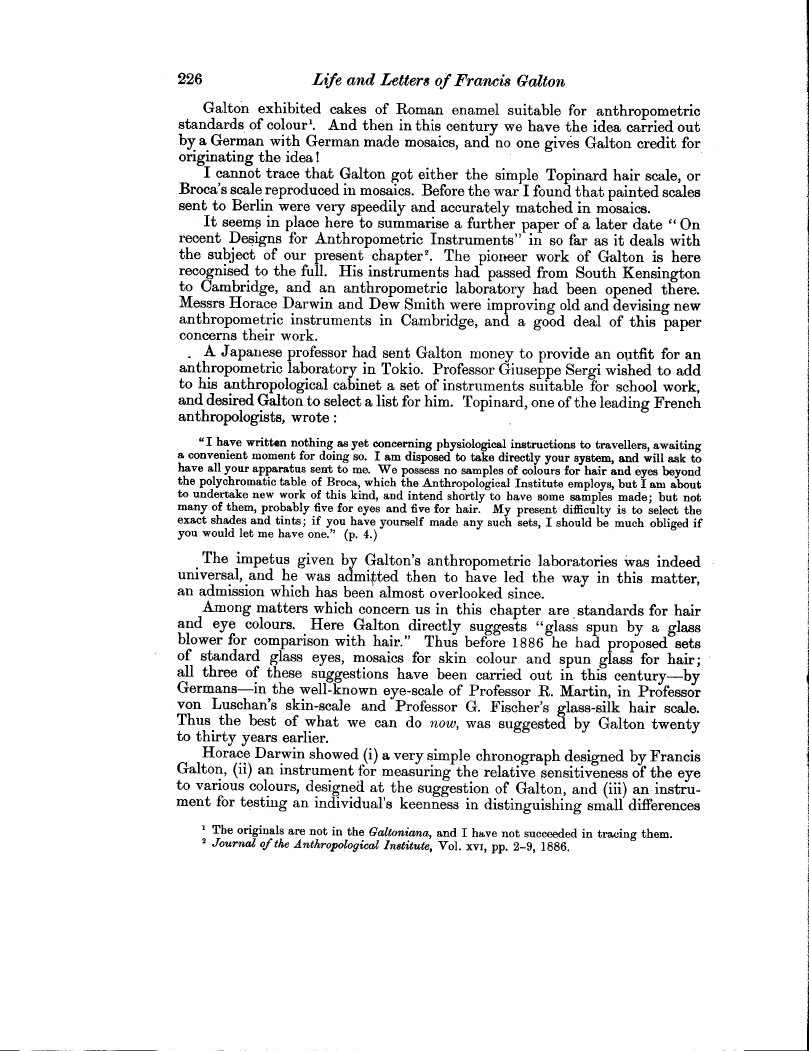226 Life and Letters of Francis Galton
Galton exhibited cakes of Roman enamel suitable for anthropometric standards of colour'. And then in this century we have the idea carried out by a German with German made mosaics, and no one gives Galton credit for originating the idea !
I cannot trace that Galton got either the simple Topinard hair scale, or Broca's scale reproduced in mosaics. Before the war I found that painted scales sent to Berlin were very speedily and accurately matched in mosaics.
It seems in place here to summarise a further paper of a later date " On recent Designs for Anthropometric Instruments" in so far as it deals with the subject of our present chapter'. The pioneer work of Galton is here recognised to the full. His instruments had passed from South Kensington to Cambridge, and an anthropometric laboratory had been opened there. Messrs Horace Darwin and Dew Smith were improving old and devising new anthropometric instruments in Cambridge, and a good deal of this paper concerns their work.
A Japanese professor had sent Galton money to provide an outfit for an anthropometric laboratory in Tokio. Professor Giuseppe Sergi wished to add to his anthropological cabinet a set of instruments suitable for school work, and desired Galton to select a list for him. Topinard, one of the leading French anthropologists, wrote
"I have written nothing as yet concerning physiological instructions to travellers, awaiting a convenient moment for doing so. I am disposed to take directly your system, and will ask to have all your apparatus sent to me. We possess no samples of colours for hair and eyes beyond the polychromatic table of Broca, which the Anthropological Institute employs, but I am about to undertake new work of this kind, and intend shortly to have some samples made; but not many of them, probably five for eyes and five for hair. My present difficulty is to select the exact shades and tints; if you have yourself made any such sets, I should be much obliged if you would let me have one." (p. 4.)
The impetus given by Galton's anthropometric laboratories was indeed universal, and he was admitted then to have led the way in this matter, an admission which has been almost overlooked since.
Among matters which concern us in this chapter are. standards for hair and eye colours. Here Galton directly suggests "glass spun by a glass blower for comparison with hair." Thus before 1886 he had proposed sets of standard glass eyes, mosaics for skin colour and spun glass for hair; all three of these suggestions have been carried out in this century-by Germans-in the well-known eye-scale of Professor R. Martin, in Professor von Luschan's skin-scale and Professor G. Fischer's glass-silk hair scale. Thus the best of what we can do now, was suggested by Galton twenty to thirty years earlier.
Horace Darwin showed (i) a very simple chronograph designed by Francis Galton, (ii) an instrument for measuring the relative sensitiveness of the eye to various colours, designed at the suggestion of Galton, and (iii) an instrument for testing an individual's keenness in distinguishing small differences
' The originals are not in the Galtoniana, and I have not succeeded in tracing them. 2 Journal of the Anthropological Institute, Vol. xvi, pp. 2-9, 1886.

